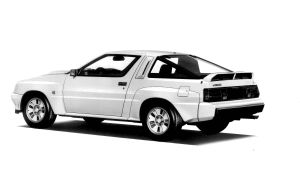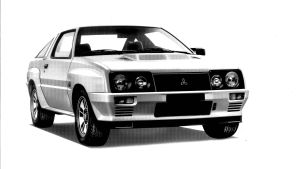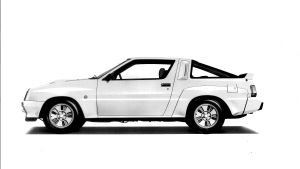Fresh light has been cast on Mitsubishi’s stillborn attempt to join the likes of the Audi Quattro and Ford RS200 in rallying’s craziest era, after previously unseen official sketches of the company’s Starion 4WD were discovered in the depths of an archive.
These artist’s impressions, published here for the first time, were sent as part of internal correspondence at Mitsubishi’s UK importer in 1984. They show the company was serious about building 200 roadgoing examples of the Starion 4WD - the number required to rubber-stamp its participation in Group B rallying.
The Mitsubishi project remains one of world rallying’s ‘lost cars’, alongside Ford’s rear-wheel-drive Escort RS1700T (abandoned in favour of the RS200) and mid-engined versions of the Audi Sport Quattro that were tested behind the Iron Curtain in Czechoslovakia but ultimately dismantled after the project was discovered.
Conceived as the follow-up to the rear-drive Lancer 2000 Turbo, the Starion 4WD was developed by the Ralliart team in the UK, under the direction of former driver Andrew Cowan and with input from former Audi technician Alan Wilkinson. It would have had a 2.0-litre engine in production form - in effect, an updated version of the Lancer’s motor - and this would have been expanded to 2,140cc for the 20 ‘evolution’ competition specials that would have been allowed under Group B rules.
The engine is estimated to have had around 350bhp, and extensive use of carbonfibre and kevlar for the bodywork is said to have kept the car’s kerbweight at just over 1,000kg. These numbers would have been a solid base for the Starion 4WD to be competitive, at least until even more brutal versions of the Quattro and Peugeot’s 205 Turbo 16 arrived in the second half of 1985.
The most obvious difference between the Starion 4WD and its conventional rear-drive production stablemates is at the front, where the regular car’s pop-up headlights have been replaced by a conventional quad-lamp arrangement. This, in turn, allowed Cowan and his engineers to drastically shorten the Starion’s front overhang, helping to improve its weight distribution, while also squeezing in a larger radiator.
A letter accompanying the images suggests that Mitsubishi was planning to put numbered plaques on all of the Starion 4WDs, and says that the car was being lined up to make its debut at the 1984 British motor show. This would tally with the development rally car’s appearance on that summer’s Mille Pistes Rally, a notoriously rough event held on the huge Canjuers military base in southern France, where it finished sixth in the hands of Mitsubishi test driver Lasse Lampi.
The car also ran in prototype form as part of a national event rolled into the 1984 RAC Rally - but the project dragged badly and while homologation was expected to be sealed sometime in 1986, the cancellation of the Group B class in spring of that year forced the Starion 4WD to be abandoned.
The work on the proposed model wasn’t a complete waste, however; Mitsubishi and particularly Ralliart took knowledge on engines and transmissions gleaned from the project and fed it into a new challenger for the more production-based Group A regulations: the Galant VR-4. That car scored the Japanese brand’s first WRC victories, persuading it to commit further with the Lancer Evo that went on to win four back-to-back World Rally Championships for Tommi Makinen, as well as a makes title for the Japanese brand itself in 1998.
Ralliart is returning to motorsport. Read more here...
from Sitewide RSS feed https://ift.tt/3yKYMhA




No comments:
Post a Comment